| Back to Back Issues Page |
 |
|
Bangkok Travelbug January 2017 San Chao Rong Thong Market Ang Thong January 06, 2017 |
| Hello
Wiset Chai Chan – a brief history Mueang Wiset Chai Chan or Wiset Chai Chan City was in existence since the Ayutthaya days though records don’t specify exactly when the city was founded. Located on the banks of the Noi River*, it’s 33 km north-west of Ayutthaya and serves as a frontier outpost covering the northern approaches to Ayutthaya against any Burmese incursions. *The Noi River starts from Chai Nat and winds past Singburi, Ang Thong, and rejoins the Chao Phraya at Bang Sai, Ayutthaya 
Noi River at Wiset Chai Chan In 1765, when the Burmese started their offensive against Ayutthaya, Wiset Chai Chan was overrun and occupied. Many of the warriors withdrew north to an encampment called Bang Rachan where they joined others in a heroic last stand against the Burmese. That battle goes down in the annals of Thai history as one of supreme heroism and sacrifice. We will be covering this battle next month. Later during the Thonburi era in the late 18th C, a new city was established on the banks of the Chao Phraya River 12 km east of Wiset Chai Chan. As the area was in a fertile river basin, the new city was named Ang Thong or Golden Basin. Today Ang Thong City is the centre of a fertile rice growing, milling and exporting region. The old Wiset Chai Chan is now a district in Ang Thong Province. 
Rice field in Ang Thong Contents San Chao Rong Thong Market San Chao Rong Thong is an old Chinese community that migrated to Wiset Chai Chan around the 19th C. They started their community on the banks of the Noi River and in the tradition of the Chinese migrants became traders selling various types of food, fruits, vegetables and other goods. From this Chinese community grew the San Chao Rong Thong Market which specialises in delectable Thai cakes, deserts and snacks. 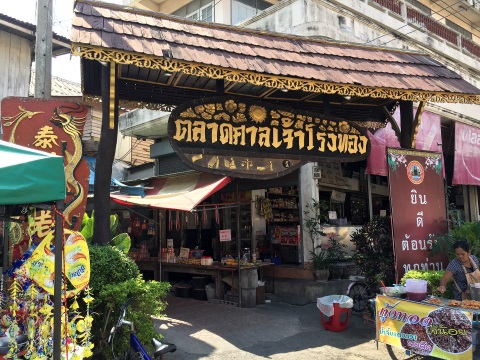
Entrance to the market We walked down the narrow alleys lined with shops on both sides. In communities like these, the traders live above the shops where they sell their wares like many Chinese communities overseas. 
Alley leading into the market Here’s a sample of some of the goodies sold here. 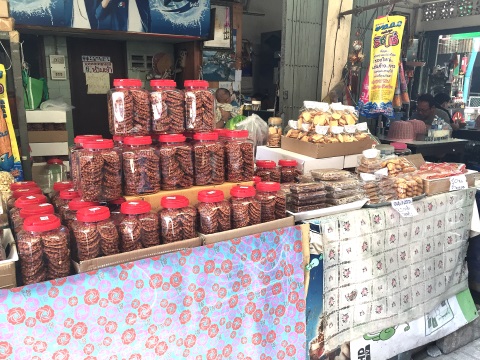
Sample of some of the snacks This was the first stall we stopped at and this lady sportingly allowed us to take her photo and what she had on sale in her stall. 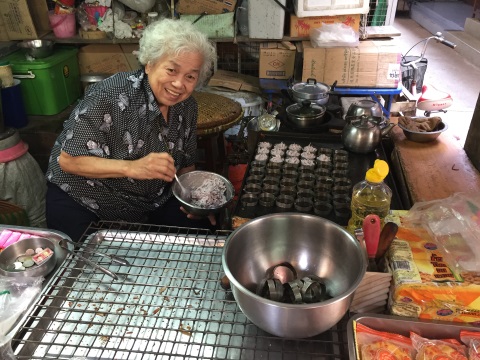
The friendly face of San Chao Rong Thong 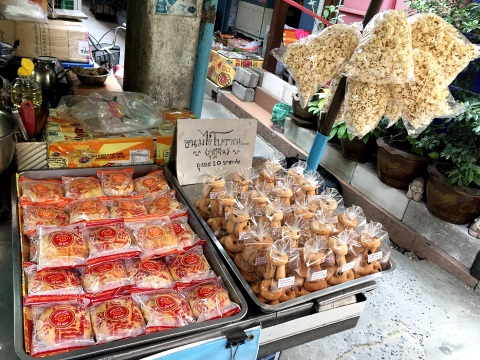

We stopped at a second shop and this lady was nice enough to invite us into her kitchen to show us the preparation of her cakes. Her shop takes orders for such cakes for gifts during festive seasons. 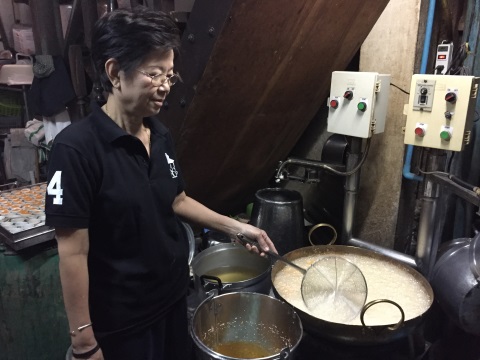

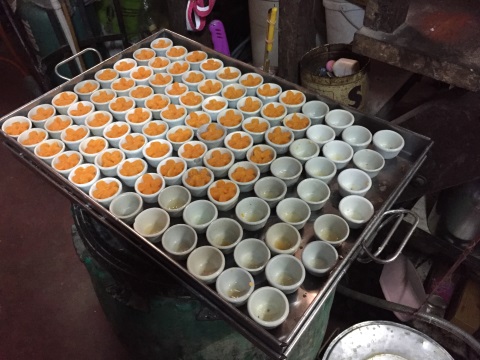
Preparation of kanom thong yip 

Some of her colourful snacks and her shop 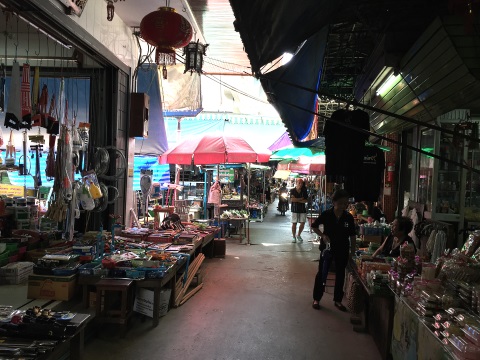
In the heart of the market Though San Chao Rong Thong market is famous for its cakes and deserts, other goods are sold here too; like hardware items, farm tools, fresh orchids, garlands, salted fish and chunks of raw pork. 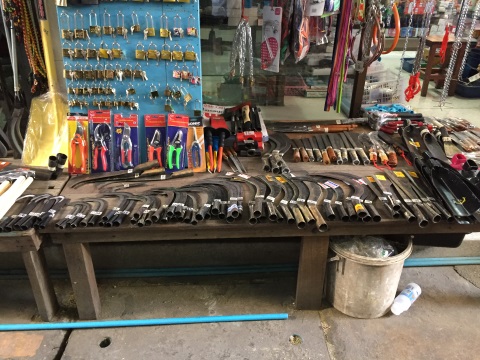
Hardware shop selling sickles for harvesting rice 


Another colourful array of cakes and sweets After the first row of shops, I noticed a sharp difference with the rest of the buildings; the houses were different, many were closed and there didn’t seem to be any life there. 
A different atmosphere It was then that I found out from the lady who owns the cake shop, that a big fire burnt down a large portion of the San Chao Rong Thong community many years ago. As we walked to the river we passed more shops that were closed. Some appeared newly renovated but remained closed. 
Closed There’s a small neat park just before the river but there was hardly anyone there. Barges moored by the river appear to be the dining area in what used to be a floating market. 
Park and moored barges The second section of San Chao Rong Thong was in strange contrast to the busy and bustling front section. Contents Tragedy at Dawn It was in this latter section that we found out more about this community. These old pictures, hung from the walls of a wooden house that is the home of the community leader, tell the story. Early on the morning of 6 December 2005 at about 3:00 am a huge fire broke out in San Chao Rong Thong. The damage was devastating; almost half the wooden buildings in the community were completely destroyed! 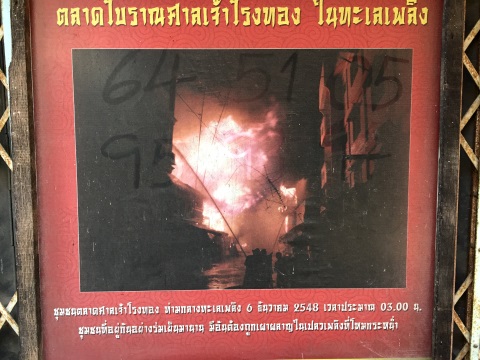

The fire and its aftermath From the information on these display boards, the community apparently is more than 150 years old. It was originally called by another name, Ban Pai Cham Sin. Later a prominent member of the community who was a Chinese immigrant built a beautiful shrine here using earth that had a golden hue. Many people came to worship at this shrine and in 1877 the name of the community was changed to San Chao Rong Thong (san chao – shrine, rong thong – gold) . The date of change in name for the community 1877, shows that the community started before this date. There is no record as to when exactly it started. These old photos show what the community was like back then. 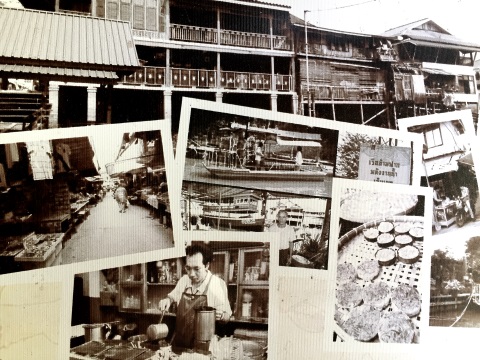
Life back then Across from this house is another wooden hut that displays a collection of old items and photographs. 
Old items on display in the museum 
These old photos were taken in 1974 Contents Kuan Yu Shrine Now to our final destination in our tour of the San Chao Rong Thong community and market, the Kuan Yu Shrine. It’s a beautiful shrine overlooking the Noi River dedicated to the Chinese deity Kuan Yu. 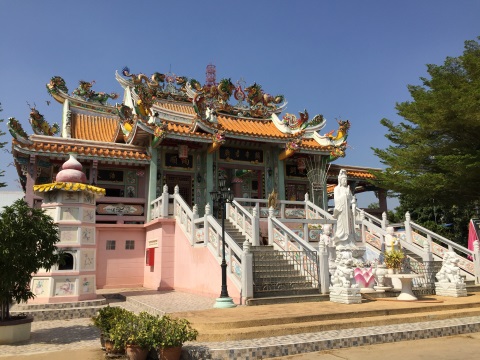
Kuan Yu Shrine An elderly lady was seated near the shrine and told us to proceed upstairs. She gave a call and within five minutes a young man appeared to guide us around the shrine. Aou the young man was born and grew up in San Chao Rong Thong. Like many of the residents here, he is in the third or fourth generation. During the weekends, he performs a service to his community and volunteers as a guide to the Kuan Yu Shrine as the regular person is off. In the previous section, it was stated that the community was named after a shrine, but the information didn’t specify which shrine. It’s most likely this Kuan Yu Shrine, the most prominent shrine in the community 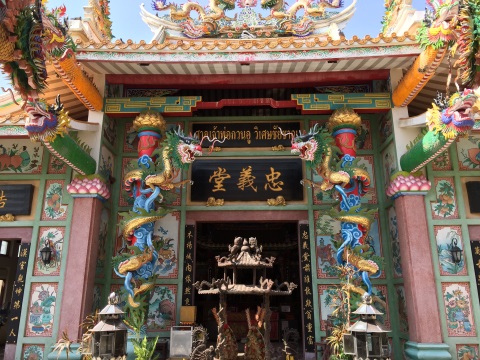
Entrance to the shrine Kuan Yu, a famous Chinese general from the 2nd and 3rd C during the tumultuous civil wars in China, is immortalized in the Chinese historical novel, “Romance of the Three Kingdoms”. He is renowned for his courage, integrity, loyalty and sense of righteousness. 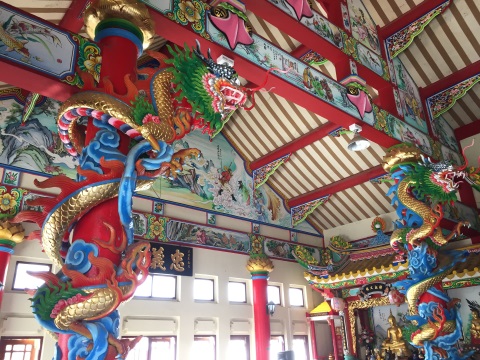
Inside the shrine Kuan Yu is called the God of War or Warrior God in English because of his military prowess and fierce expression with a dark face and long flowing beard and kuan tao, a broad sword on a long shaft. Sometimes he carries an axe on a long shaft similar to the European halberd. 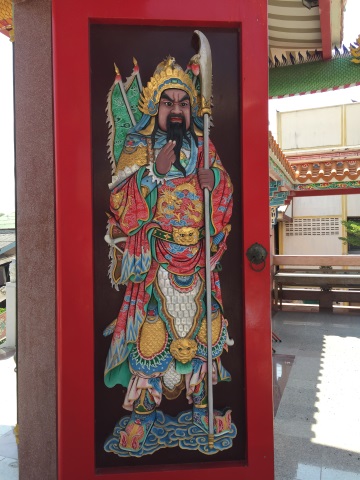
Kuan Yu in full battle array To the Chinese however, Kuan Yu represents justice and righteousness for the common man. To the Chinese immigrants fleeing a feudal China in turmoil in the 19th and early 20th C to a new land and an uncertain future, a god like Kuan Yu is a source of inspiration and spiritual strength. 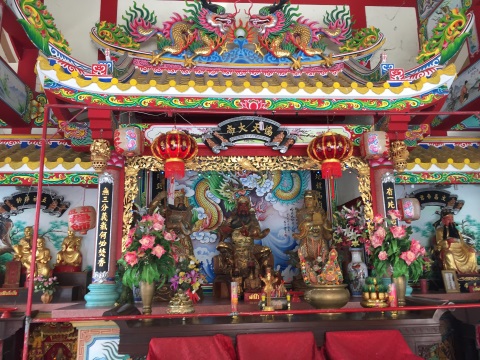
The altar - “The king who helps the heavens” Before we left, we had a parting snack; shrimps deep-fried in batter, crunchy and delicious, a fitting end to a wonderful experience at the San Chao Rong Thong Market. 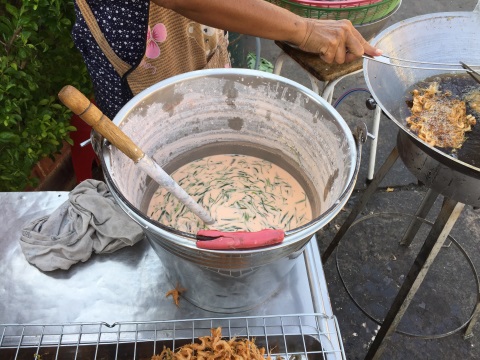
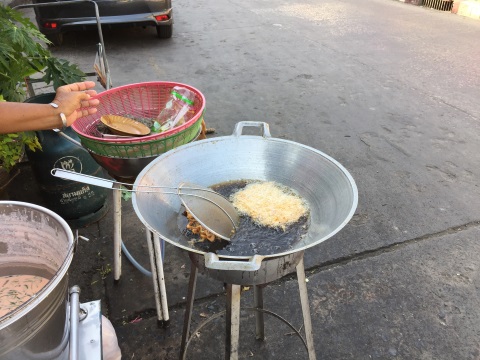
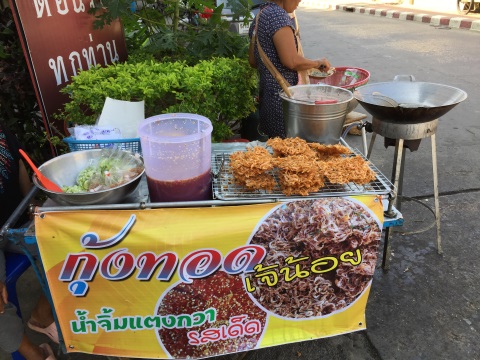
Shrimps deep-fried in batter We wish the San Chao Rong Thong community all the best for 2017 and the future and hope that they can revive their community to its former glory. Old communities like these with a rich cultural heritage embody the very soul of the society. Contents Our thanks Our thanks to the people of San Chao Rong Thong Community whom we had the pleasure of meeting. They were extremely nice and helpful to us. In particular, our thanks to Aou our guide for showing us around the Kuan Yu Shrine. Contents Map to San Chao Rong Thong Market If the map doesn’t appear, click on this link Address How to get there By car From Bangkok get on the Don Muang Tollway (Highway 1) – Highway 32 – Highway 309 which will take you past Ayutthaya. Continue on to Ang Thong, go through Ang Thong City to Highway 3064 – Highway 3195 all the way to Wiset Chai Chan. Parking Park in the grounds of Wat Nang Nai which has ample free parking space. The market is just behind the temple. There is very limited parking along the narrow road leading to the market. Opening hours and admission fees Open every day, from 0900 – 1600 hours, Admission is free Contents Next month Bang Rachan Fort Heroes’ Memorial, Singburi If you enjoyed reading this e-zine, please forward it to a friend. If you received this from a friend and found it interesting, please subscribe at Bangkok Travelbug. What do you think of the Bangkok Travelbug? We love to hear from you What other subscribers have said Till next month then. Eric Lim Tour Bangkok Legacies Find us on Facebook If you are an independent traveller, here's a handy e-guide book, Tour Bangkok Legacies, which will help you along as you explore the streets of Bangkok and discover its old treasures. It's complete with historical descriptions, maps and detailed directions on how to get to these places. My Kindle e-book 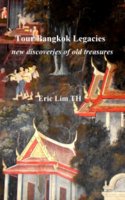
Copyright@2008-2016 Tour Bangkok Legacies All rights reserved
|
| Back to Back Issues Page |